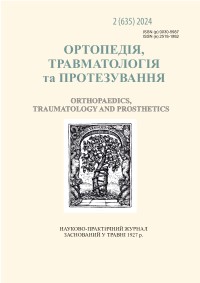STRESS-DEFORMED STATE OF THE ACROMIOCLAVICULAR JOINT IN CASE OF DAMAGE TO THE UPPER ACROMIOCLAVICULAR LIGAMENT SUPERIOR AND VARIOUS METHODS OF FIXATION
DOI:
https://doi.org/10.15674/0030-59872024233-41Keywords:
Acromioclavicular joint, ligaments, fixationAbstract
During the operative stabilization of the acromial end of the clavicle (AEC) for its dislocation, there are two ways: clavicle – beaklike process, clavicle – acromial process. Fixation of the AEC to the acromial process of the scapula is a priority. Competing metal structures are the hook plate and the Weber method. The significant disadvantages of using the Weber method of fixation are the migration of the tips and the violation of their integrity and
the wire. Objective. To conduct a comparative analysis of the fixation of the acromial end of the clavicle according to Weber, hook plate and the proposed construction, by studying the stressed-deformed state of the clavicular-acromial joint in case of damage to the lig. acromioclavicular superior and various methods of fixation. Methods. A finite-element model of the clavicular-acromial joint was constructed. Damage to the ligaments was modeled. claviculo-acoacromiale superior, as well as fixation of AEC in three ways: according to Weber, hook plate and the proposed construction. Results. The best results, from the point of view of reducing the level of stresses in intact ligaments, are provided by fixation of the AEC according to Weber, but its use leads
to an increase in the level of stresses on the AEC and the acromial process of the scapula, which can cause destruction of the latter. The hinge-type fixator provides the best stress distribution, both in the bony elements of the model and in intact ligaments. The hook plate holder occupies an average position,
both in terms of the level of stress and the magnitude of the relative deformations in the ligaments. Conclusions. Weber fixation provides the best results for reducing the level of stresses and relative strains in the intact ligaments, but leads to a several-fold increase in the level of stresses on the AEC and acromial process of the scapula. The hook plate holder occupies an average position, both in terms of the stress level and the magnitude of the relative
deformations in the ligaments. The proposed design provides the best stress distribution, both in the bony elements of the model and in the intact ligaments.
References
- Buryanov, O. A., Kvasha, V. P., Chekushin, D. A., & Naumenko, V. O. (2021). Analysis of long-term results of surgical treatment of dislocations of the acromial end of the clavicle. Trauma, 22(6), 4-9. doi.org/10.22141/1608-1706. (in Ukrainian)
- Fade, G. E., & Scullion, J. E. (2002). Hook plate fixation for lateral-clavicular malunion. АО Dialogue, 15(1), 14-18.
- Judet, J. (1976). Les luxations acromoclaviculares recentes. Chirurgi, 102(12), 1016-1019.
- Pan, X., Lv, R., Lv, M., & Zhang, D. (2020). TightRope vs clavicular hook plate for Rockwood III–V Acromioclavicular dislocations: A meta-analysis. Orthopaedic Surgery, 12(4), 1045-1052. https://doi.org/10.1111/os.12724
- Ozan, F., Gщk, S., Okur, K. T., Altun, İ., Kahraman, M., Gгnay, A. E., & Yamak, K. (2020). Midterm results of tension band wiring technique for acute Rockwood type III Acromioclavicular joint dislocation. Cureus. 12(12): e12203. https://doi.org/10.7759/cureus.12203
- Bur’yanov, O. A., Kvasha, V. P., Martsyokha, A.V. & Chekushin, D. A. Patent No. 12472, UA MPK A61B17/56. Extra-articular dynamic fixator for dislocations of the acromial end of the clavicle; O.O. Bogomolets National Medical University. Application u201709326; 15,11.2017; 25.04.2018, Bul. No. 8. (in Ukrainian)
- Cowin, S. C. (2001). Bone Mechanics Handbook. 2nd ed. Boca Raton: CRC Press.
- Boccaccio, A., & Pappalettere, C. (2011). Mechanobiology of fracture healing: Basic principles and applications in orthodontics and orthopaedics. Theoretical Biomechanics. https://doi.org/10.5772/19420
- Niinomi, M. (2008). Mechanical biocompatibilities of titanium alloys for biomedical applications. Journal of the Mechanical Behavior of Biomedical Materials, 1(1), 30-42. https://doi.org/10.1016/j.jmbbm.2007.07.001
- Berezovsky, V. A., & Kolotilov, N. N. (1990). Biophysical characteristics of human tissues. Directory. Kyiv: Naukova Dumka. (in russian)
- Karpinsky, M., Yaresko, O., Pavlenko, K., Topor, V., Uvarova, O., & Popov, O. (2014). Mathematical modeling of options for osteosynthesis of middle third clavicle fractures. ORTHOPAEDICS, TRAUMATOLOGY and PROSTHETICS, 0(4), 5. https://doi.org/10.15674/0030-5987201445-13
- Chang, Y., Hughes, R. E., Su, F., Itoi, E., & An, K. (2000). Prediction of muscle force involved in shoulder internal rotation. Journal of Shoulder and Elbow Surgery, 9(3), 188-195. https://doi.org/10.1067/mse.2000.105135
- Rao, S. S. (2005). The Finite Element Method in Engineering: Elsevier Science 14. Kurowski, P. M. (2007). Engineering Analysis with COSMOSWorks 2007: SDC Publications.
Downloads
How to Cite
Issue
Section
License

This work is licensed under a Creative Commons Attribution 4.0 International License.
The authors retain the right of authorship of their manuscript and pass the journal the right of the first publication of this article, which automatically become available from the date of publication under the terms of Creative Commons Attribution License, which allows others to freely distribute the published manuscript with mandatory linking to authors of the original research and the first publication of this one in this journal.
Authors have the right to enter into a separate supplemental agreement on the additional non-exclusive distribution of manuscript in the form in which it was published by the journal (i.e. to put work in electronic storage of an institution or publish as a part of the book) while maintaining the reference to the first publication of the manuscript in this journal.
The editorial policy of the journal allows authors and encourages manuscript accommodation online (i.e. in storage of an institution or on the personal websites) as before submission of the manuscript to the editorial office, and during its editorial processing because it contributes to productive scientific discussion and positively affects the efficiency and dynamics of the published manuscript citation (see The Effect of Open Access).














